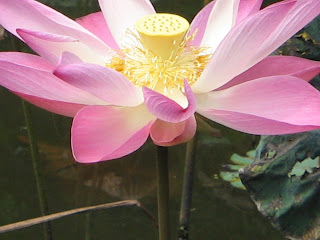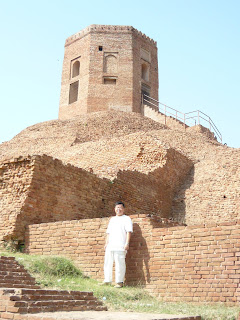
Wednesday, April 29, 2009
Prayers for His Highness

Monday, April 27, 2009
Dhamma for Politicians
 Wesak Day falls on May 9 this year.
Wesak Day falls on May 9 this year. 

In The Buddha's Footsteps (11)
Left Sarnath today at about 7.30am for a 300km journey to Savatthi. By noon we stopped at a coffeeshop for lunch.
Took two pieces of capati's. It taste the same as those I usually eats in Malaysia but the size is much smaller. It costs only 5 rupees each.
We arrived at the Wat Maha Rishii Prisert at about 5.30pm after travelling for about 10 long hours. After settling ourselves, we had dinner consists of noodles and fried rice ( rice was leftover from lunch) which was cooked by volunteers in our group since the temple do not have anystaff to assist us other than the lone caretaker.
Within the Wat Maha Risshi Prisert is a stone image of the monk himself.
We woke up early the next morning to catch the morning sunrise at a hilly sacred site not far from the temple.
After breakfast at the Wat Maha Rishii we proceed to the main and most important Buddhist site in Savatthi, the Jetavana monastery.
When I initially started to study the sutta's during my university days, the name Jetavana and Ananthapindika has been mentioned umpteen times in many of the suttas. My visit to Jetavana this time gave a sense of great excitement as I can relate the Buddha to the suttas that he delivered here which I first study years ago.
Buddha spent many of His rains retreat in Savatthi after the wealthy merchant Anathapindika bought a park from Prince Jeta and developed it into the Jeta Grove, Anathapindika's Park or more popularly known as Jetavana.
The Jetavana park comprised many temples, structures and facilities.
Jetavana park is very well maintained by the local authorities.
The Gandhakuti (background) is the place where the Buddha used to stay when He is in Savatthi. The Jetavana Gandhakuti was built in the middle of the monastery.
After Jetavana, we visited the site of the new Wat Thai Chetawan in Savatthi. This new temple is to replace the Wat Maha Risshi Prisert which was hand over to the Cambodian government due to the previous chief monk who has dual Thai and Cambodian nationality.
We went back to the Wat Maha Rishii for lunch before departs for Lumbini at about 1pm.
During the journey to Lumbini, the left tyre of bus no. 2 punctured and we took the opportunity to disembark to see the surrounding areas.
This water pump is a regular feature in all the villages that we passes through during our journey. The ground water is cool and crystal clear.
This guy on my right is our bus driver. We were inside a small tea stall.
Our group will be crossing over the India/Nepal border via the Sonauli immigration. We arrived at a new Thai temple known as Wat Thai 960 near the border to take a rest while our passports and immigration procedures are sorted out. While waiting we helped ourselves with hot drinks and local pancakes.
Wat Thai 960 was built about two years ago in conjunction with the Cakri dynasty 9th sovereign and King Bhumipol's 60th year on the throne. The temple building costs are mostly sponsored by corporate bodies from Thailand.
It is a very cosy temple where tired pilgrims can have a good rest while waiting the long queue at the immigration. This temple even have special facilities for the usage of the royalty.
Friday, April 24, 2009
In The Buddha's Footsteps (10)
The artisans have a small smelting stove to produce clamps to hold the pieces of blocks together.
As can be seen, these blocks of stones once joined and clamped together will become a huge statue.
In The Buddha's Footsteps (9)
I shared room number 210 at the Wat Thai Sarnath with a young college chap from Thailand.
The Buddha image at the Wat Thai Sarnath are made out from a piece of stone.

It was another early rise for all of us as we will be heading to the banks of Ganges River at Varanasi. When we left the temple at about 5.20am, the roads were quiet and deserted. We reached the river at about 6.00am. Since it was still very early, the place was very calm as there was not many people there.
The sight and atmosphere at the ghats along the Ganges River was an experience that really etched deeply into my mind. The weather was just nice, cool but not cold and the boat ride was very relaxing as there was no artificial waves generated by the boats as these boats glide slowly on the river.
 All of us were given a lotus light to be floated on the river after the prayers.
All of us were given a lotus light to be floated on the river after the prayers.For those who were ordained earlier in Bodhgaya, this is the place where they throw their clump of hairs which was wrapped in yam leaves into the river. After about an hour at the site, we returned to the Wat Thai for breakfast.
The Chaukhandi Stupa marks the spot where the Buddha first met with his five companions after His Enlightenment. These five namely Kondanna, Bhaddiya, Vappa, Mahanama and Assaji were the Buddha's first disciples.
It was about 9am when we visited Chaukhandi stupa and the sun was shining brightly on us. Those who climbs up to the tower would have a great view of the surrounding areas.
After lunch, while the Thais were having a workshop discussing on their pilgrimage experience, I went to Sarnath's Archaeological Museum. The moment I steps into the museum main exhibits hall, the magnificent lion capital of Asoka Pillar welcomes all visitors. A friendly staff of the museum explains the significant of the pillar.
Other than the Asoka Pillar lion capital, the other most important exhibit is the one that depicts the Buddha delivering His first sermon Dhammacakkappavatana Sutta. This image is widely used in publications and also produced in smaller sizes and sold as souvenirs.
The Mulagandhakuti Vihara built in 1931 contains the relic of the Buddha which was kept in the main shrine. The walls are wrapped with murals depicting the life of the Buddha which was painted by the famous Japanese artist, Kosetsu Nosu.This image depicts Buddha during His first sermon.
Anagarika Dharmapala ( 1864 - 1933), was instrumental towards the formation of Maha Bodhi Society in 1891 and initiated the efforts to reclaim the Maha Bodhi Temple from the Mahant. The Mulagandhakuti Vihara was built by him in 1931.

This bell was constructed by the Tibetans exiled in India as a symbol of gratitude to the Indian government and her people.

Later in the afternoon we went to the Dharmekh Stupa for our prayers and also meditation session. This gigantic stupa provide the shades that shelters us from the setting sun. The well kept lawn, the shade and the cool breezes presents to us a great atmosphere for the moment of peace and tranquility. Our chants vibrates against the stupa wall and resounding all over the vast garden. It was one of the best moment of tranquility during my pilgrimage.






































